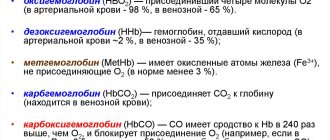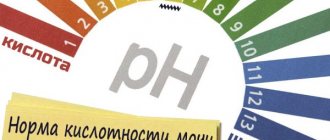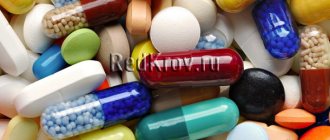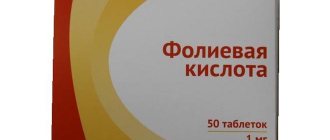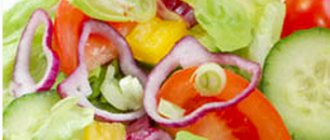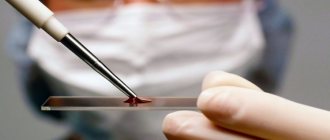Symptoms of hemoglobin deficiency in the blood
You can find out that the level of hemoglobin in the blood has dropped below normal by certain symptoms. The appearance of this pathological condition is indicated by:
- bluish skin;
- cyanosis of mucous membranes;
- severe weakness;
- chronic headaches;
- noise in ears;
- severe dizziness;
- constant drowsiness;
- increased fatigue;
- loss of weight and interest in food;
- dyspnea;
- disruption of the menstrual cycle in women (up to its complete disappearance);
- decreased potency in men (to the point of complete inability to have sexual intercourse);
- severe tachycardia;
- heart failure;
- stabbing chest pain;
- fainting;
- black dots before the eyes.
Depending on how much hemoglobin has dropped, the patient’s symptoms will be more or less pronounced. In severe cases of the disease, if there is no possibility of urgent medical care, there is a high risk to the patient’s life. Therefore, in such cases, therapy is carried out in a hospital setting.
Prevention of elevated hemoglobin
Preventive measures against increasing the concentration of Hb in the blood consist of maintaining a healthy lifestyle:
- cessation of alcohol abuse, smoking and psychotropic drugs;
- maintaining a proper diet;
- drinking large amounts of clean water without gas;
- limiting physical and emotional overload;
- health status monitoring – annual scheduled examinations and maintenance therapy for chronic diseases.
Clinical manifestations
Symptoms of the condition depend on the underlying causes, as well as the individual characteristics of the body. In some cases, high hemoglobin may not manifest itself in any way.
We can assume the presence of deviations based on external signs:
- a sharp decrease in performance;
- drowsiness;
- lethargy;
- deterioration or complete loss of appetite;
- decreased sensitivity of taste buds;
- decreased quality of vision;
- dysfunction of the genitourinary system;
- pale skin.
On a note! More serious are the processes that develop inside the body with high hemoglobin. The blood becomes more viscous, making it difficult for it to fully circulate through the vessels. This causes the formation of cholesterol plaques and blockage of blood vessels in various organs. This can subsequently lead to atherosclerosis, the risk of heart attacks and strokes.
Symptoms of deviation
Symptoms of elevated hemoglobin levels in men are:
- Decreased visual acuity;
- Hearing impairment;
- Insomnia or drowsiness;
- Digestive disorder in which constipation alternates with diarrhea;
- Painful sensations in the muscle area;
- Joint pain;
- Frequent headache and dizziness;
- Abdominal pain;
- Tendency to thrombosis of blood vessels;
- The appearance of areas of redness on the skin, alternating with flaky spots;
- Itching of the skin, especially after water procedures;
- Paleness of the skin of the extremities;
- Numbness of fingers and toes;
- Increased blood pressure;
- Rapid formation of bruises and hematomas;
- Frequent bleeding.
Products that lower hemoglobin
To normalize hemoglobin levels, following a certain diet plays an important role.
The basic principles of this diet are directly opposite to those that underlie the recommendations regarding the diet for low hemoglobin. How to lower hemoglobin at home? First of all, you should limit your intake of proteins and animal fats, as well as any foods that are red in color and high in iron. Exclude from the diet:
- Red meat;
- Offal and liver;
- Smoked meats;
- Some cereals (especially buckwheat);
- Red fruits and berries, as well as black currants;
- Butter;
- High fat milk.
Eating large amounts of fat leads to increased cholesterol levels, which form plaques on the walls of blood vessels. In combination with increased blood viscosity, this significantly increases the possibility of blood clots and blockage of blood vessels. It is recommended to include in your menu:
- Fish, preferably river;
- Seafood: mussels, squid, shrimp, seaweed;
- Vegetables (raw and stewed), especially sauerkraut and spinach, which reduces iron absorption;
- Cottage cheese and fermented milk products;
- Fruits (bananas, apricots, grapes);
- Lemons;
- Cranberries (this is an acceptable exception to red berries);
- Oats and pearl barley;
- Soybeans, legumes and nuts.
Seafood and fish contain omega-6 and omega-3 polyunsaturated fatty acids, which help thin the blood and at the same time strengthen the walls of blood vessels. Therefore, it is also useful to take fish oil.
You need to drink as much water as possible - the hemoglobin content in the blood directly depends on the amount of fluid in the body. You should drink little and often, as otherwise the load on the heart increases.
Once or twice a week you can have fasting days: cottage cheese-kefir or vegetable.
With elevated hemoglobin, mineral and multivitamin complexes and complexes containing iron, copper and B vitamins (B6, B9, B12) are contraindicated.
The most effective is complex therapy for high hemoglobin, including taking medications, following a diet and good physical activity.
What should be excluded from the diet?
For greater effectiveness, when following a diet, be sure to exclude from the diet foods that cannot be eaten with increased hemoglobin:
- Fat meat. Particularly “dangerous” are beef, pork, as well as meat by-products (liver, lungs, heart, kidneys, and so on). Meat is rich in iron, as well as B-group vitamins (therefore, iron from such products is easily absorbed).
- Pomegranate and pomegranate juice. Pomegranate increases hemoglobin and blood pressure. For hypotension, it is extremely useful to include in the diet, but with increased blood viscosity, it should be completely excluded.
- Fatty fish. Rich in omega-3 acids, which accelerate most intercellular metabolic processes. Their use should be minimized. You can also include other seafood here, including oysters, shrimp, red and black sparkle, and seaweed.
- Chicken eggs. More precisely, it is the yolks (but the whites – slightly, but still reduce hemoglobin). It is also better to exclude quail from the diet.
- Spices. Turmeric especially strongly increases hemoglobin (it contains not only iron and herbs (parsley, dill, basil), but also B-group vitamins). It is better to temporarily stop using them altogether.
- Cherries and sweet cherries. These berries raise hemoglobin levels no worse than pomegranate and pomegranate juice.
Danger
The topic of how to lower hemoglobin arose due to the fact that its high content can lead to some consequences. The blood becomes too viscous, and this, in turn, makes it difficult to move. Blood circulation is impaired. This leads to the formation of blood clots and blockage of blood vessels. This may result in stroke, heart attack, deep vein thrombosis, or pulmonary embolism.
In addition to such serious consequences, there are also less dangerous, but also unpleasant. A person begins to feel worse, the quality of sleep deteriorates, and fatigue quickly sets in. Possible increased blood pressure, loss of appetite, regular headaches, itching of the skin, pain in the bones.
Consequences
Elevated hemoglobin is dangerous to health. It undermines the proper functioning of all organs and systems in the body. Thickened blood slows down brain function; the kidneys, spleen and liver increase significantly in size.
The blood thickens and becomes too viscous, which leads to blood clots. Blood vessels become clogged with plaque. As a result, thrombosis occurs. High concentrations of protein provoke the development of heart attack, stroke, gout, and pulmonary embolism.
If pregnancy is accompanied by increased hemoglobin, dangerous complications can develop. In women carrying a child, their kidneys and liver suffer greatly.
A high concentration of hemoglobin is a dangerous disease. It is impossible to cope with it on your own. It is necessary for the doctor to understand the causes of the pathology and prescribe effective treatment.
Reducing hemoglobin at home
If a problem with blood thickness begins to arise, it can be solved at home.
- Every day for 3 months you need to drink a 3-liter bottle of water, to which add juice squeezed from 2 lemons. The water must be filtered.
- For breakfasts you need to prepare fruit salads made from grapes, apricots, bananas.
- Having decided to be treated with herbal teas, you should be careful. Nettle should not be taken in preparations - it greatly increases hemoglobin levels. Only woodlice, chickweed and fireweed can reduce it. They can be used in any form, but the best results will be obtained if you make salads from these herbs.
- As for seafood, you should eat shellfish, but not the fish itself or algae - they contain a lot of iron.
- Porridges that will help you cope with the blood problem are: buckwheat, pearl barley, rice, oatmeal, as well as cranberry juice. A variety of nuts, sauerkraut, spinach, soybeans, and river fish are very useful for men.
Diet food
Rational consumption of food is considered the most effective method in the fight against high hemoglobin levels. At home, it is easy to normalize its concentration if you follow simple rules of a healthy diet.
Foods you shouldn't eat
When the blood becomes viscous, there is a risk of blood clots, you should not eat certain types of meat or dairy products, fruits and vegetables. Liver is prohibited, as well as all other by-products that can raise the concentration of red blood cells in the blood even higher.
You can't eat red meats. It can be replaced with non-fatty poultry. Products such as butter, milk or high-fat sour cream should be reduced to a minimum. Cranberries, seaweed, red currants, apples, red beets, pomegranate, tomatoes, strawberries, raspberries, and cherries are prohibited.
They contain iron, which is now in excess in the body. You should not eat sweet or smoked foods. You should absolutely not drink alcohol, otherwise if alcohol enters your body, your hemoglobin level will increase due to the breakdown of alcohols.
What is good to add to your diet?
focus on vegetarian dishes to thin it . It is advisable to diversify your menu with:
- low-fat cottage cheese, fermented milk products, soft varieties of cheese;
- peas, beans, soybeans, beans;
- walnuts, pistachios, peanuts;
- rice, buckwheat, whole grain bread;
- juices from any fruits and berries, except red varieties and apples;
- herbal drinks instead of caffeinated drinks.
It is recommended to increase the amount of fluid you drink during the day. It is better to replace solid foods with soups, broths, but not fatty ones. It is healthier to cook vegetable dishes in a double boiler or eat them stewed, boiled, or fresh . You are allowed to eat chicken or fish fillet 2 times a week. It is useful to arrange a fasting day every 7 days - then only liquid is consumed for 24 hours - water, juice, herbal decoction.
Causes of high hemoglobin
Internal causes of increased hemoglobin in men:
- Endocrine diseases;
- Oncological diseases;
- Allergic reactions;
- Dehydration of the body;
- Burns;
- Chronic stress;
- Intestinal obstruction;
- Hypoxia (oxygen starvation);
- Taking medications from the group of corticosteroids or diuretics;
- Respiratory diseases (emphysema, pneumonia, tuberculosis, bronchial asthma, bronchitis);
External causes of high blood hemoglobin levels in men include:
- Active smoking, as a result of which hypoxia develops;
- Professions associated with prolonged stay at high altitude (pilots, climbers);
- Engaging in heavy sports (weightlifting, speed skating);
- Long-term living in high mountain areas with low oxygen content in the air.
When you know why hemoglobin in the blood of men increases, you need to start treatment and diet, otherwise complications are possible.
Other ways to lower hemoglobin
The methods used by men and women to lower hemoglobin in the blood were described in detail above. However, there are a number of less common methods, but this does not mean that they are less effective.
A decrease in the concentration of iron-containing protein in erythrocytes is also facilitated by:
- electrophoresis;
- hirudotherapy;
- bloodletting;
- taking mummy capsules;
- drinking water for a month to which natural lemon juice is added;
- eating fresh fruit salads for breakfast.
To reduce hemoglobin in women, men and children, as well as to avoid relapse of this disorder, you must follow a few simple rules:
- Do not take vitamin complexes under any circumstances, since hypervitaminosis is one of the causes of increased hemoglobin;
- take medications regularly - lack of systematicity reduces the effectiveness of such treatment;
- maintaining a moderately active lifestyle;
- rejection of bad habits;
- frequent exposure to fresh air.
In addition, you should take a general clinical blood test every six months to monitor the functioning of the circulatory system, obtain complete information regarding the condition of the entire body, as well as prevent the development of complications that may develop if the hemoglobin level is not reduced in a timely manner. The level of hemoglobin in the blood should always be kept under control.
Reducing hemoglobin with diet
If a person has an elevated hemoglobin level, then the menu also plays an important role in stabilizing the condition. So, what foods can lower hemoglobin in the blood?
The list of foods that you can eat is considerable, it includes:
green and yellow vegetables (preferably seasonal); porridge (legumes - with caution); vegetable fats; fermented milk products with low fat content; seafood and white fish.
All those who suffer from increased hemoglobin in the blood should drink more fluids.
It is not necessary to drink only water; you can add freshly squeezed juices, jelly, herbal teas, and compotes to your daily menu. It is better to refrain from drinking coffee, strongly brewed black tea, and most importantly, alcohol.
In addition, the menu should be adjusted in such a way as to exclude red meat and offal, animal fats, vegetables, fruits and berries with an intense red tint, and sweets.
Despite the fact that it is better to minimize the consumption of fatty dairy products with elevated blood hemoglobin, low-fat cottage cheese, kefir and milk are still worth eating. They are rich in calcium, which prevents the absorption of iron by the gastrointestinal tract.
Fans of alternative medicine often try to find the answer to the question of how to reduce hemoglobin using folk remedies. The answer is not obvious.
Video:
https://youtube.com/watch?v=q4B7UF0Psto
Indeed, there are various folk recipes consisting of various ingredients that can reduce the level of this substance in human blood.
However, you should not use prescriptions without the consent of your doctor, so as not to cause accidental harm to the body.
The most common “folk” way to combat high hemoglobin is the use of mumiyo. You can purchase this substance at any pharmacy.
Increased hemoglobin is not a disease, but a consequence of some pathological condition occurring in the human body.
To bring the level of this indicator back to normal, you need to undergo a series of examinations to identify the reason for its increase, and strictly follow the recommendations of your doctor.
If you ignore the problem and do not take any measures to eliminate it, you can provoke the risk of serious diseases.
Herbs for low hemoglobin
Often, to normalize hemoglobin levels, people resort to herbal treatment. Herbal infusions have proven themselves well:
Herbal collection No. 1
Take equal quantities (50 g each) of medicinal plants such as celandine herb, mistletoe, lavender, rue, rose hips.
Mix all ingredients, take 1 tablespoon of herbal mass and pour 250 ml of boiling water over it. Cover with a lid, leave for 3 hours, strain.
Drink the medicine warm three times a day before meals. When the herbal infusion runs out, you must take a week-long break, during which you need to take a blood test.
If hemoglobin decreases slightly during this time, you can continue the treatment course.
Herbal tea No. 2
Take 50 g of chamomile flowers, veronica herb, and 100 g of rose hips. Mix everything, take 1 teaspoon of the mixture and pour boiling water (200 ml) over it.
Leave for half an hour, strain, drink a whole cup after meals twice a day. Each time you need to prepare a fresh decoction.
Herbal tea No. 3
Mix the following plants: shepherd's purse grass, dandelion root, horsetail grass, mistletoe. Take all ingredients in equal quantities - 30 g each.
Pour boiling water over one tablespoon of the mixture and leave. Take 3 times a day 15 minutes before meals.
When treating high hemoglobin with herbal infusions, you need to prepare a fresh healing drink each time, because after standing even for several hours, the infusion loses its medicinal properties.
Traditional treatment methods
Herbs, berries, fruits, and vegetables are used for treatment.
Lemon juice
Lemon water is an effective folk method used to normalize hemoglobin levels. Dissolve 50 ml of freshly squeezed lemon juice in 3 liters of cool water. The entire volume is drunk throughout the day. The course of treatment is three months.
Mumiyo
People with thick blood are recommended to use mumiyo. They are treated for 10 days. They rest for 5–7 days. They do a repeat course. How to take the medicine:
- The mummy capsule is dipped into a small amount of warm water;
- Stir and drink before bed.
It is forbidden to use sleeping pills, sedatives, alcohol, or smoke cigarettes together with mumiyo..
Herbal infusions
Herbal infusions effectively thin the blood. They are prepared according to the following recipes:
- Mix 50 g of valerian, St. John's wort, willow bark, lavender, celandine, rose hips. Pour 4-5 tablespoons of raw material into a liter of boiled water. Leave for two hours, filter. Drink a glass of medicine three times a day.
- Combine 50 g of dandelion rhizomes, horsetail, mistletoe, and shepherd's purse. Add 3 teaspoons of herb to 250 ml of boiling water. Drink as tea after meals.
- Take 50 g of chamomile and veronica and 100 g of rosehip. Place a teaspoon of herb in 200 ml of boiling water. After cooling, filter. Drink a glass after meals twice a day.
- Make a mixture by taking 50 g of celandine, lavender, rose hips, mistletoe, and rue. Pour a tablespoon of the mixture into 200 ml of boiled water. After three hours, filter. You should drink a glass of the product before meals three times a day.
Since infusions quickly lose their healing properties, they are prepared immediately before use. Treat with herbs for 14–20 days. There is a week break between courses. After treatment, blood is donated for testing. If the hemoglobin concentration has dropped slightly, treatment is continued.
Pharmacy fees
Pharmacies sell preparations that can lower hemoglobin. They improve the synthesis of iron-containing protein, regulate blood density, and have an anti-inflammatory effect. The mixture includes: elecampane, cuckoo flax, fireweed and other plants.
Preparations are prepared using 2 methods:
- Boil 350 ml of water, pour into a thermos, pour 1 tablespoon of the mixture into the liquid, and leave until the morning. Drink 1/3 glass 3 times a day before meals. The interval between eating and taking the medicine is half an hour.
- Grind 1 teaspoon of herb in a coffee grinder to a powdery state. The dry powder is washed down with water, or combined with honey, licorice or rosehip syrup. Use 3 times a day. They eat after a 15-minute interval.
Emergency care for patients
If a person’s blood has become too viscous and thick, it cannot circulate normally through the vessels, he needs urgent help.
Knowing how to reduce hemoglobin in the blood quickly and without negative consequences, you can save the health and even life of a loved one:
- Shilajit - this remedy helps to quickly thin the blood. You need to dissolve one tablet of the drug in water and drink the medicine before going to bed. The duration of treatment is 10 days, after which you must take a break and then repeat the course. With this drug you can quickly reduce your hemoglobin levels.
- Erythrocytophoresis is the fastest way to reduce hemoglobin in the blood. The procedure is carried out in a hospital setting. Erythrocytophoresis is a blood transfusion procedure; during manipulation, specialists remove part of the red blood cells - blood cells containing hemoglobin. After these cells are removed, the blood is returned to the patient.
- Hirudotherapy - treatment with leeches. These medicinal annelids also help to quickly reduce hemoglobin. Leeches contain hirudin in their saliva, an enzyme that reduces blood viscosity. Having bitten through human skin, the leech sucks out about 5 ml of blood from it. Then, within 24 hours, another 30 ml of blood flows out of the resulting wound. Hirudotherapy is contraindicated in people with a tendency to bleed.
Normal for the male body
It must be remembered that hemoglobin levels for men and women differ. The normal level in men depends on age:
- 120 – 160 g/l in adolescents from 12 to 14 years old;
- 115 – 165 g/l in adolescents from 15 to 18 years;
- 132 – 173 g/l in men from 18 to 44 years old;
- 131 – 172 g/l in men from 45 to 64 years old;
- 126 – 174 g/l in men over 65 years of age.
Elevated levels of red blood cells and hemoglobin can be detected by taking a general blood test. This is a traditional part of any medical research. The higher the level of red blood cells in the blood, the higher the hemoglobin.
You can read about increased hemoglobin in women here.
Diagnostic methods and preparation
Diagnosis of hemoglobin level is mandatory when conducting a general blood test. The duration does not exceed 1 day. The biomaterial for analysis is venous or capillary blood. To obtain the most reliable results, you must follow the preparation recommendations:
- eliminate fatty and fried foods for 1 day;
- blood is donated strictly on an empty stomach, the last meal taken at least 8 hours before;
- within half an hour, physical and emotional stress is limited;
- You must not smoke for 1 hour.
Interpretation of results and norm
Important: the interpretation of the data obtained should only be carried out by the attending physician.
Otherwise, the risk of incorrect diagnosis and selection of treatment methods that will worsen the patient’s condition cannot be excluded.
Reference (normal) values are selected individually for each patient, taking into account gender, age and menstrual cycle.
| Floor | Age | Hemoglobin norm, g/l |
| Both | 0 – 14 days | 135-200 |
| Up to 1 month | 100-170 | |
| 1-2 months | 95-130 | |
| 2-4 months | 100-140 | |
| 4-6 months | 110-140 | |
| 6-9 months | 100-150 | |
| 9-12 months | 115-145 | |
| 1-5 years | 110-150 | |
| 5-10 years | 115-145 | |
| 10-12 years | 120-160 | |
| Man | 12-15 years | 120-160 |
| 15-18 years old | 120-170 | |
| 18-45 years old | 130-170 | |
| 45-60 years | 140-175 | |
| Over 60 years old | 120-175 | |
| Woman | 12-15 years | 110-150 |
| 15-18 years old | 120-155 | |
| 18-45 years old | 115-160 | |
| 45-60 years | 120-160 | |
| Over 60 years old | 110-170 |
It should be noted that even with a normal quantitative content of red blood cells in the blood, a deviation from the reference values of the Hb indicator may be observed.
A small one-time deviation from the norm is not a cause for concern. In other words, if hemoglobin 160 is detected in a patient under the age of 18, then there is no need for additional laboratory and instrumental examinations.
Despite the difference in normal values for different sexes, hemoglobin 150 g/l is considered the optimal value for both women and men.
Reasons for increased hemoglobin
In the case of an excessive amount of hemoglobin in the blood, one must first look for the cause, which leads to an increase in the production of an enzyme that is directly involved in the transport of bound oxygen to the tissues of the body.
For example, climbers and mountain residents have traditionally high levels of iron-containing protein. But its increase can occur in anyone who is at altitude with thin air for a long time.
In addition, the following factors may contribute to the increase in this protein:
- stressful situations that contribute to increased blood pressure;
- polycythemia vera;
- erythrocytosis;
- oncological diseases;
- congenital or acquired heart diseases;
- smoking;
- chronic diseases of the lungs and heart;
- taking diuretics;
- injections of erythropoietin to improve performance in sports;
- permanent residence or stay in mountainous areas where the oxygen content is minimal.
Symptoms of excessively high protein levels:
- bad feeling;
- high blood pressure;
- various sleep disorders;
- weight loss;
- red spots on the skin;
- bloody stools;
- skin irritation;
- elevated body temperature.
High levels of iron protein are most often detected during a medical examination for another illness. The doctor, who conducts a more thorough examination, knows how to reduce hemoglobin.
Reasons for increased hemoglobin in the blood in men and women
The amount of hemoglobin in the blood can be influenced by all sorts of factors, both external and internal.
- Environmental conditions. At low oxygen concentrations, which is typical for high mountain areas, the body switches to an enhanced operating mode. This leads to an increase in hemoglobin levels.
- Features of the profession. This factor is related to the previous one and is typical for pilots, flight attendants, installers, rock climbers, rescuers, etc. Also, a high level of hemoglobin is observed in professional athletes involved, for example, in wrestling, weightlifting, skiing, running and its variations.
- Excess carbon dioxide. It can be associated both with the characteristics of the work (workers in “harmful” industries, miners, etc.) and with living in places with high air pollution (industrial zones).
- Taking anabolic drugs. Anabolic steroids (including steroids) not only allow you to quickly produce muscle tissue and give the body a beautiful contour, but also cause a deterioration in overall health due to a sharp increase in the concentration of red blood cells and a jump in the hemoglobin level.
In addition to external reasons, internal factors can also lead to an increase in hemoglobin in adults, as well as in adolescent children:
- cardiac, pulmonary or renal failure;
- problems with the gallbladder;
- bone marrow hyperactivity;
- dehydration due to various reasons, including illness, drinking disorders, physical labor in high temperatures;
— pregnancy (albeit in rare cases, the body can react to this condition anyway);
- hypervitaminization of the body (vit. B), excess iron, use of certain drugs.
In addition to those listed, there are also probabilistic factors. They can cause an increase in blood viscosity, and, consequently, an increase in hemoglobin levels in the blood, with some probability.
For example, overwork, exposure to stress, and nicotine addiction can lead to both a sharp increase in this indicator and a decrease in it.
Infants may experience an increase in blood viscosity due to oxygen starvation during fetal development. This occurs as a result of dysfunction of the placenta.
As a rule, this indicator gradually returns to normal with proper care. But there are cases when a completely healthy baby shows signs of increased hemoglobin due to the parents’ misconception about the conditions that are comfortable for the child.
Excessive wrapping, warming, maintaining a high temperature in the children's room, and lack of ventilation lead to an overestimation of this parameter in the baby.
Normal hemoglobin content in the blood
Due to the difference in gender and age, its meaning varies among people. Average readings are considered to be from 110 to 170 grams per liter. There are pathologies in one direction or another.
A decrease in indicators indicates the presence of anemia. Exceeding the level of the substance is possible in healthy people, but it can also indicate the presence of a serious disease. Most often, you have to solve the problem of a low level of a substance in the blood. However, the opposite situation also forces us to look for a solution to the problem. These indicators are probably known to everyone who has taken a blood test at least once. For the vast majority of people, it is not difficult to name the norm of hemoglobin in the blood without thinking. It should be clarified that the normal level of the substance for the male half of the population is somewhat different from the female half. This is explained by the physiological characteristics of the female body, which loses blood every month during menstruation. Pregnancy also affects the level of this substance in a woman's blood. This is explained by an increase in plasma volume during pregnancy and, accordingly, blood thinning. But this condition is considered physiological, so there is no need to talk about norms here.
Everyone's norms are different
The following values are accepted as the norm, differing depending on gender and age. Hemoglobin level in women: 115-145 g/l, and during pregnancy the lower threshold is 110 grams per liter. Children: for newborns 115 -180 g/l, up to two years of age: 105 - 150 g/l, up to 15 years of age: 110-155 g/l, from 16 years of age the level is the same as for an adult. With age, the level of the substance in the blood changes slightly. In women over 40 years of age, the blood protein level increases to 160 g/l. For women over 50, the norm is 138 g/l.
If blood levels exceed the norm in women after 40 or after 50 years, you need to know what values to take as acceptable and how to lower hemoglobin.
Normal hemoglobin level in men
From 16 to 40 years old, 130-160 g/l is considered the norm. In men after 40 years of age, the rate rises to 180 g/l. After reaching the age of 50, the level of this protein changes slightly; for men, this norm decreases to 150 g/l. If the deviation from the normal level is not too great, then it is quite possible to correct its value using various non-drug methods, as well as reduce the level using folk remedies. In cases where the discrepancies with the norm are too great, it is imperative to resort to all available means to quickly bring the indicators back to normal.
Prevention
It is necessary to reconsider your daily diet.
It is necessary to exclude foods with high iron levels:
The new menu should lead to the following:
- seafood;
- cottage cheese;
- poultry meat;
- salads;
- legumes;
- berries;
- spinach;
- herbal teas that can reduce hemoglobin.
Hardening, an active lifestyle, and swimming give good results. Smoking and alcohol should completely disappear from a man’s life. It is very useful to drink carrot and beet juice every morning, arrange fasting days, and do exercises.
As an option for men, you can become a donor, then young healthy blood will be constantly produced.
To reduce hemoglobin, a man should switch to vegetarianism. This will remove toxins from the body and cleanse the blood vessels. The bone marrow, which is responsible for blood quality, will function properly.
Normal blood glucose levels in men
If your child has enlarged tonsils
Diet
To lower hemoglobin levels, a special therapeutic nutrition system is used, which involves minimal consumption or complete rejection of protein-rich foods. Such food provokes an increase in the concentration of iron in the blood.
The diet includes avoiding confectionery, fatty meats, and smoked foods. The emphasis is on the consumption of fruits, vegetables and berries with a high content of ascorbic acid.
These include:
- bananas;
- pineapples;
- grape;
- apricots;
- citrus.
Red apples, tomatoes, and tomatoes are strictly prohibited.
It is necessary to exclude all foods high in iron from the diet:
- liver;
- peanut;
- processed cheese;
- beef;
- pork;
- beans;
- wheat flour products.
Soy, river fish, and spinach will help reduce hemoglobin in the blood of women and older men. Introducing white cabbage and low-fat fermented milk products into the therapeutic diet.
Chicken fillet, rich in amino acid compounds and practically devoid of a lipid layer, is suitable for a therapeutic diet. The body cannot function normally without protein, so mushrooms and seafood are introduced into the diet, which do not help increase hemoglobin.
The ideal choice for quickly improving the rheological properties of blood is considered to be a traditional vegetarian diet, the main emphasis of which is on green table vegetation.
It is advisable to give preference to liquid dishes over solid ones, and boiled, steamed and stewed ones over fried ones. Fasting days are of great benefit. But here a consultation with a nutritionist is necessary.
Traditional medicine for normalizing hemoglobin
Folk remedies are used for many diseases and pathologies. To achieve a positive effect from such therapy, you need to adhere to the proportions and recommendations of a specialist who will help you choose the right remedy to reduce hemoglobin in men and women.
Shilajit is considered a good traditional medicine for normalizing this component in the blood. It can be purchased at any pharmacy. To achieve a positive effect from this therapy, it is recommended to dissolve one tablet in 100 ml of warm water. It is better to drink the product before going to bed. The course of treatment should not exceed 7-9 days. You can repeat the treatment after 6-7 days, but not earlier, so as not to cause harm.
During the period of using mumiyo, you should not take sedatives or sleeping pills, and do not forget about alcoholic beverages and smoking. If you exercise and eat right during this therapy, the lowering effect will occur much faster.
It is possible to reduce hemoglobin using folk remedies without drug therapy, but they affect each patient differently. Choosing the optimal method can only be done in practice. In most cases, it is recommended to use herbal preparations in compliance with all proportions.
The best hemoglobin-lowering herbs:
- Collection No1. The composition of this herbal collection helps not only reduce hemoglobin, but also normalize blood circulation. It contains rose hips, willow bark, St. John's wort, lavender, valerian and celandine. All components are taken in equal proportions to obtain a total of 150 g of the mixture, which will need to be brewed in a liter of boiling water. This decoction should be infused for 1.5-2 hours. After cooling, strain and drink before each meal. The course of treatment should not exceed 18-22 days. Therapy can be repeated after 5-8 days.
- Collection No2. Has a positive effect on the blood, reduces its thickness. The collection includes chamomile, veronica and mistletoe. All components are taken in equal parts and mixed with 120 g of rose hips. The mixture is poured with boiling water and infused for no more than 40 minutes. You should drink the decoction after every meal, but not more than 12-15 days. After which it is recommended to get tested. If the hemoglobin level does not become low within normal limits, the course can be repeated.
- Collection No3. To prepare it you need to take dandelion root, horsetail, mistletoe and shepherd's purse. All components are taken in equal proportions, 40-52 g each. Then 3 teaspoons of the mixture should be brewed with a glass of boiling water for 30-45 minutes. Take the product for 14-18 days several times a day after meals.
After hemoglobin levels from folk remedies are normalized, it is recommended to adhere to proper nutrition and an active lifestyle.
Hirudotherapy
Hirudotherapy is a method of lowering hemoglobin, similar to bloodletting. Therapy involves exposure to leeches on the body. In addition, their saliva is rich in the enzyme hirudin, which reduces the ability of blood to clot and reduces its viscosity. Thus, the risk of blood clots is reduced and blood microcirculation is improved.
In one session, one leech sucks approximately 5 ml of blood. After this, over the next day, about 30 ml of lymph, blood and intercellular fluid come out of the wound. Regular procedures will lead to a decrease in hemoglobin. To achieve significant results, you will have to attend several sessions.


